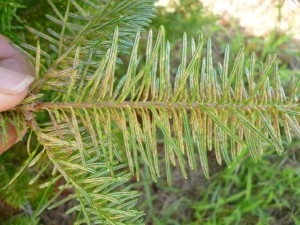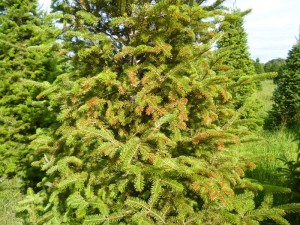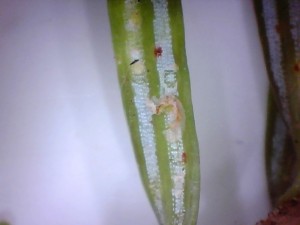Armored scales are generally regarded by green industry plant managers as being one of the more difficult insect pests to control. The Cryptomeria scale (Aspidiotus cryptomeriae ‘Kuwana’) is an armored scale that is notorious for being especially difficult to detect because of the translucent waxy cover. The elongate hemlock scale species resembles this scale, but it has a waxy cover that is caramel brown in color. Although the hosts of Cryptomeria scale can potentially include numerous conifer species, they are most typically found on hemlocks & pines in the landscape and on true firs in production situations such as Christmas tree farms. The damage potential is especially high on true firs.
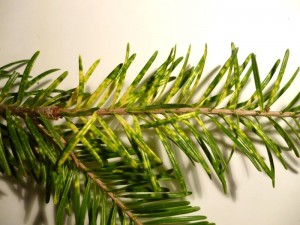
Chlorotic banding & mottling symptoms produced by Cryptomeria scales on Fraser fir (Photo: Steven K. Rettke)
Observing Symptoms & Signs
Cryptomeria scales can quickly overwhelm true firs in landscapes, nurseries or Christmas tree farms. Christmas tree farms growing Fraser, Canaan, and balsam firs need to understand the high damage potential from this scale & be especially vigilant to take the time to monitor for its presence. When monitoring, inspect the undersides of the needles on the lower, inner branches. The scale has the look of a “fried egg” & has a highly flattened appearance. The thin waxy cover of younger scales are almost transparent & do not become more opaque until they reach maturity. When observing the scales on leaf undersides, it is often possible to still see the rows of white stomata on the needle through the nearly transparent waxy covers. When populations are high, the upper needle symptoms will have a mottling or chlorotic banding appearance. These scales feed within plant cells & remove green chlorophyll. These symptoms will usually be most obvious & easily observed at the lower branches.
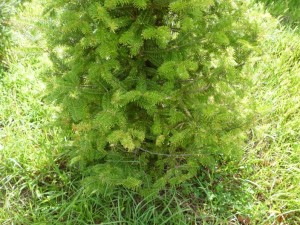
When monitoring for Cryptomeria scale, inspect the undersides of foliage at the lower, inner branches
(Photo: Steven K. Rettke of RCE)
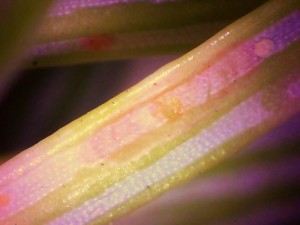
Must observe closely to detect the “fried egg” appearance of a maturing female
(Photo: Steven K. Rettke of RCE)
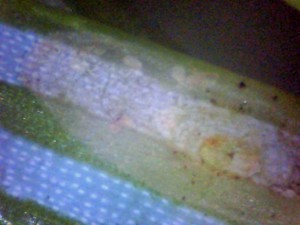
The nearly transparent waxy cover of the Cryptomeria scale. The white lines of the leaf stomata are still visible, as well as recently hatched yellow crawlers.
(Photo: Steven K. Rettke of RCE)
Crawler Emergence
Similar to many other armored scale species, the Cryptomeria scale has more than one generation of crawlers during the growing season. In New Jersey, this scale has two crawler generations per year & they generally begin in June & then again in August. First generation crawlers begin to emerge at 600-800 GDD’s. Second generation crawlers begin to emerge at 1750-2130 GDD’s. Crawlers are lemon yellow in color & because of the color contrast can typically be easy to observe on needles, even without a hand-lens. Unfortunately, the crawler emergence periods of both generations of Cryptomeria scale are not restricted to only a week or two. Their more prolonged crawler periods can extend for 4 weeks or even longer, although a large percentage of crawlers will occur during the first 2 weeks after emergence begins.
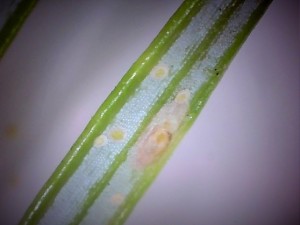
Mature Cryptomeria scale at center & numerous younger instars with developing waxy covers
(Photo: Steven K. Rettke of RCE)

The lemon yellow color of the recently hatched crawler has moved away from home
(Photo: Steven K. Rettke of RCE)
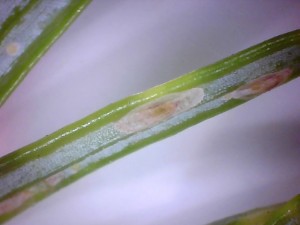
Mature female Cryptomeria scale at center compared to smaller mature male at right
(Photo: Steven K. Rettke of RCE)
Control Strategies
When applying control materials with short residuals (e.g., horticultural oils), the use of multiple applications will probably be required to achieve a more complete crawler suppression. If a single application is desired, then oils plus synthetic pyrethroids can provide a 3 week residual. Examine infested trees closely in order to determine if significant predators or parasitoids are presently active. When numerous, these beneficials can be extremely valuable to help with suppression. Therefore, the use of horticultural oil applications alone will help conserve the beneficials & still control crawlers when coverage is adequate. The use of most of the neonicotinoid insecticides (e.g., Merit) will not achieve satisfactorily controls (maybe only 30-40% efficacy). However, the usage of dinotefuron (Safari) as a soil drench or bark spray has been shown to give excellent results against armored scales, with some studies showing 90% efficacy. The extremely high water solubility of Safari allows this material to penetrate into the plant cells where the scales are actually feeding.
